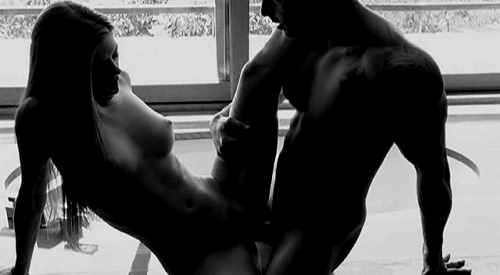Excerpts from this paper and interviews relating to topic can be found in Ad Age, Religioscope, Huffington Post, Agency Spy and The National.

I’ve seen plenty of things making FUN of us. We would love to be part of a general marketing campaign if the media world would accept Muslims as a common part of the North American diaspora.
-Amethyst, Creator of Ninjabi
It is impossible for media to recognize the emergence of the Black Nerd as a lifestyle when the media on a whole chooses not to look at Black Males directly in the eye. I’m glad that popular culture is [now] recognizing us, if only to use that recognition to sell us more bullshit.
-Dallas Penn, Blogger
Introduction
Advertising in the United States has often influenced the pop-culture identities of religious and ethnic minorities. To be targeted by marketers serves as an invitation to join in the national narrative of capitalism. To shop is to be an American.
While this act of inclusion has merit, it has also fostered myopic marketing campaigns. Rather than diversity being, well, diverse, minority-targeted advertising often traffics in reductive stereotypes of soul claps and sombreros. While some of this is due to those creating content, it is also the fault of mass media, one historically comprised of “few senders and many receivers.” (Anderson 2003)
But this is slowly changing. In 2008, with the new media environment of blogs, video and social networks, we are beginning to see a more accurate depiction of minority groups. Why? Because there is more content and the media is being created by them, not about them. Dialogue is supplanting monologue.
In the coming years, the US market will likely begin to recognize and court the $170 billion purchasing power of American-Muslims. To date, pop-culture representations of Islam are either cloaked in evil or infused with pathos. But as Hallmark, Wal-Mart and 20th Century Fox begin creating content geared toward this demographic, it will slowly help to prove that American-Muslims are not only ‘as boring as the rest of us [Americans]‘ but also, as Amethyst states above ‘a common part of the North American diaspora.’
When considering this slow embrace of the Islamic consumer, our analysis must recognize legal scholar Leti Volpp’s point that:
September 11 facilitated the consolidation of a new identity category that groups together persons who appear “Middle Eastern, Arab, or Muslim.” This consolidation reflects a racialization wherein members of this group are identified as terrorists and disidentified as citizens.(2002)
With this in mind, we will look at Islamic identity within American advertising + film, mass media + new media, and how these arenas engage the act of cultural citizenship and the process of ‘being/becoming American’.
Source + Style
Given that this paper is for an academic conference, I want to make a quick note.
I was invited to contribute not as an academic, but as a working member of the American advertising industry – one that often avoids engaging the nuances of race, religion and ethnicity, instead opting for code works like ‘urban’ or window dressing for the idea of diversity. Seeing as this industry moves billions of dollars, this lack of open engagement is not just feckless, it is a missed market opportunity. Money is being left on the table. I write this paper with the hope that it might be read not only within academia, but also by members of the advertising industry. The majority of my source material is drawn from blogs, newspapers and interviews. My goal is to situate and frame various voices that are speaking about Islamic identity, as produced and consumed within America. It is an ongoing and living document.
Framing of Inquiry
Let us first examine the ways mass media in the US constructs the identities of ‘Islam’ and ‘America’:
Islam
Understanding Volpp’s point about the “consolidation [of people into] ‘Middle Eastern, Arab, or Muslim’ that are identified as terrorists and disidentified as citizens,” it is also important to note that American-Muslims are targets of both the US War on Terror and the War on Illegal Immigration. (Maira, 2008)

On the cover of the New Yorker magazine, Democratic Presidential candidate Barack Obama was portrayed as an anti-American, terrorist Muslim (flag burning in fireplace, portrait of Osama bin Laden) and his wife Michelle is portrayed as black nationalist Angela Davis, a woman who was once on the FBI Most Wanted List and politically
aligned with the Black Panthers. This picture captures (and attempts to satirize) the idea held by some that Obamas are Muslim and ergo threatening terrorist/non-citizens.
In the 1960′s Civil Rights Movement, Dr. Martin Luther King Jr. was a Christian and Malcolm X was a Muslim. X’s most famous statement is:
We declare our right on this earth to be a man, to be a human being, to be respected as a human being, to be given the rights of a human being in this society, on this earth, in this day, which we intend to bring into existence by any means necessary.
This was perceived as a stark threat to the physical and financial comfort of (White-)America. The current leader of the Nation of Islam, Minister Louis Farrkhan, is situated within mass media as anti-Semitic/anti-American, furthering the ‘threat’ of Islam.
The US government’s Pro-Israel policy is conversely Anti-Palestine and is thus imbued with and interpreted as having an Anti-Islam stance.

America
Is America Ready For a Black President? This is a question that mass media has been asking ever since Obama declared his candidacy. This question truly means, and mass-media had dodged this fact till Fall 08: Is (White-)America Ready for a Black President? This question, when placed astride racial hypens and prefixes (African-, Hispanic-, Asian-, etc), creates the impression that the only true Americans are of Anglo-Saxon descent. And let us not forget that the American promise of ‘life, liberty and the pursuit of happiness’ was accorded only to property-owning European men.
In interviews for both this paper and other Desedo research projects, many non-white interviewees see the idea/ideal of ‘America’ as something that both overtly and covertly aims to exclude them from the national narrative. This is part of the representational politics of a country that is 68% White, with a House of Representatives that is 83.5% White and the Senate, 94%.
If one is a US citizen of the hyphenate class, his supposedly inalienable rights are however often imperiled. Middle-aged Hispanic-Americans in Texas are having to prove their legal citizenship. Nineteen different states have proposed laws to re-prove citizenship in order to vote – which will primarily disenfranchise poor and/or minority Americans who do not have adequate paperwork. These are the some of the same folks who were prevented from voting in the contested 2000 Presidential race. And of course there are the hundreds of thousands of Middle-Eastern, Arabian, Desi folks who since 9/11 have been denied due process and the supposed rights of American citizenry.
In the days after 9/11, the Ad Council of America created a Public Service Announcement (PSA) called ‘I Am An American’ in “direct response to the hundreds of hate crimes against Arabs, Muslims and Sikhs.” The goal was to paint a unified yet diverse portrait of America to prevent any further attacks. Yet, shockingly, within this framework “and despite seeking to deconstruct the binary between the citizen and the terrorist, Arabs, Muslims and Sikhs are not specifically included in this diverse display. There are no visible markers of anything Arab, Muslim or Sikh in the ads – no veil, no mosque, no turban, no beard, no clothing [or] accent.” Ergo such people are not ‘An American’.(Alsultany 2007)
In June 2008, Barack Obama was giving a speech in Detroit, MI where two hijabis were asked to not stand behind him while he spoke. Their hijabs were visual signifiers of their Muslim religion, and thus un-American. Note that had they not been wearing hijabs, they may not have been ‘identified’ as Muslims, and likely not excluded from the diverse background tapestry that all political candidates seek. Interestingly enough, I posit that had a Republican candidate been on stage, s/he may have courted this ‘background’. Within American politics, both parties often play to the center in pursuit of votes – Republicans not wanting to appear too white and Democrats not wanting to appear too diverse.

Cultural Citizenship: Advertising
Given the vagaries of legal citizenship, the importance of cultural citizenship comes to the fore. Our national narrative is marked by acts and activities that are tied to an occasionally abstract idea of ‘America’ – sports like baseball or football, food like Thanksgiving Dinner, Apple Pie, McDonalds, activities like Boy Scouts, PTA, Church, etc… Like much of Brand America, these activites are seen as virtuous and ‘from the heartland’. In the post-9/11 space, The Council on American-Islamic Relations (CAIR) released a series of ads entitled ‘I Am An American Muslim’ in the effort to place Islam within this American narrative.
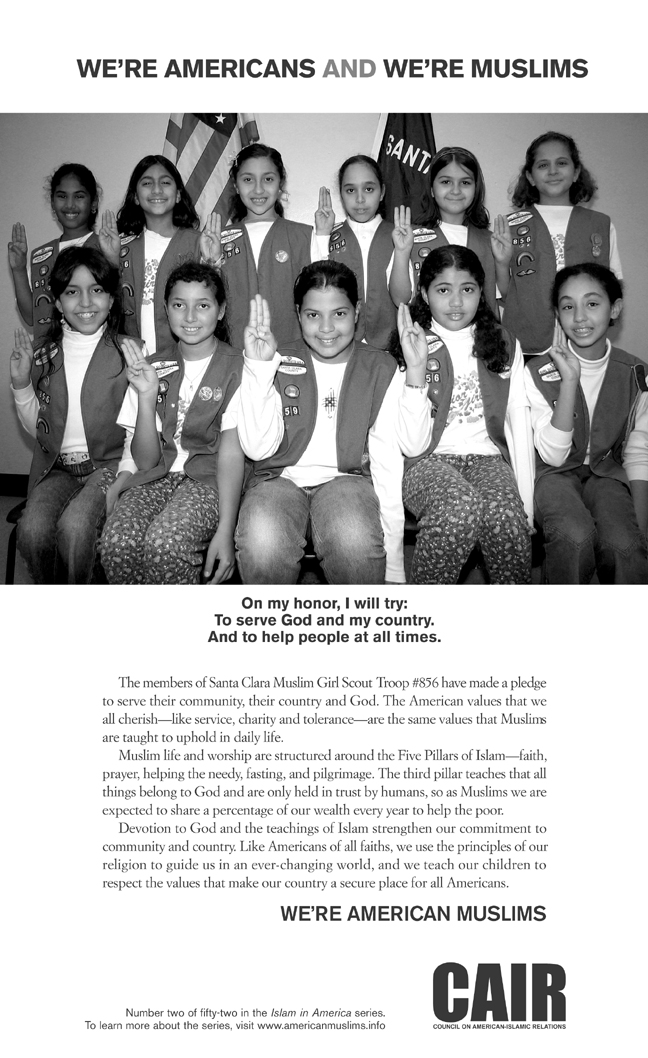
While via CAIR American-Muslims have advertised themselves within the Brand America, the reverse has not yet happened – as of fall 2008, American brands are not yet reaching out to American-Muslims and their $170B of spending power. Let us not forget that we are a capitalist country that cleaves shopping with national and religious holidays. And that president George W. Bush urged Americans to express their patriotism through the act of purchasing in the aftermath of 9/11. To shop is to be a good American.

As noted in a New York Times article about article about ad agency JWT’s study of American-Muslims:
Almas Abbasi, a radiologist in Long Island [...] said she would be grateful for advertising that included Muslims “Ramadan starts, and you see an ad in the newspaper saying, ‘Happy Ramadan, here’s a special in our store’ everyone will run to that store,” she said.

Now American brands indeed do this within primarily Islamic countries – Burger King in UAE, HP in Bangladesh, Oreos in Indonesia etc. It’s pretty mundane. But to date, no Muslim holidays are seized as a sales opportunity within the US, except perhaps in Dearborn, Michigan, a city which has the highest concentration of Muslims and Middle Eastern folks in America. Wal-Mart, the largest retailer and (private) employer of Americans in 2008, has opened a store in Dearborn designed specifically for the Muslim and Middle-Eastern consumer:
Wal-Mart offers its standard fare, plus 550 items targeted at Middle Eastern shoppers…. To fit into this bastion of ethnic tradition, Wal-Mart started two years ago to meet with imams and moms, conducting focus groups at Middle Eastern restaurants.
Walk through the front door of the 200,000-square-foot supercenter and instead of rows of checkout counters, you find a scene akin to a farmers market in Beirut. Twenty-two tables are stacked high with fresh produce like kusa and batenjan, squash and eggplant used in Middle Eastern dishes. Rimming the produce department are shelves filled with Arab favorites like mango juice from Egypt and vine leaves from Turkey used to make mehshi, or stuffed grape leaves. A walled- off section of the butcher case is devoted to Halal meats…in the freezer case, you’ll find frozen falafel. You can also pick up a CD from Lebanese pop singer Ragheb Alama or buy Muslim greeting cards.
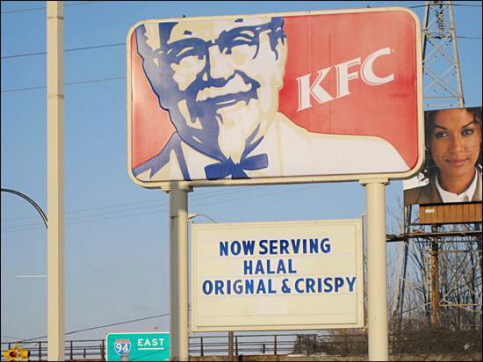
Ikea has taken similar, but smaller, measures to court Dearborn shoppers and the local McDonalds and KFC serve halal. On the national scale, Hallmark carries Eid cards and the United States Postal Service issued an Eid stamp in 2001 (thought there was a backlash in which people attempted to boycott the stamp because Eid spelled backwards is ‘Die’) But that’s about it, except, as a friend reminded me, “in advertisements for Universities to emphasis their ‘diversity’.”
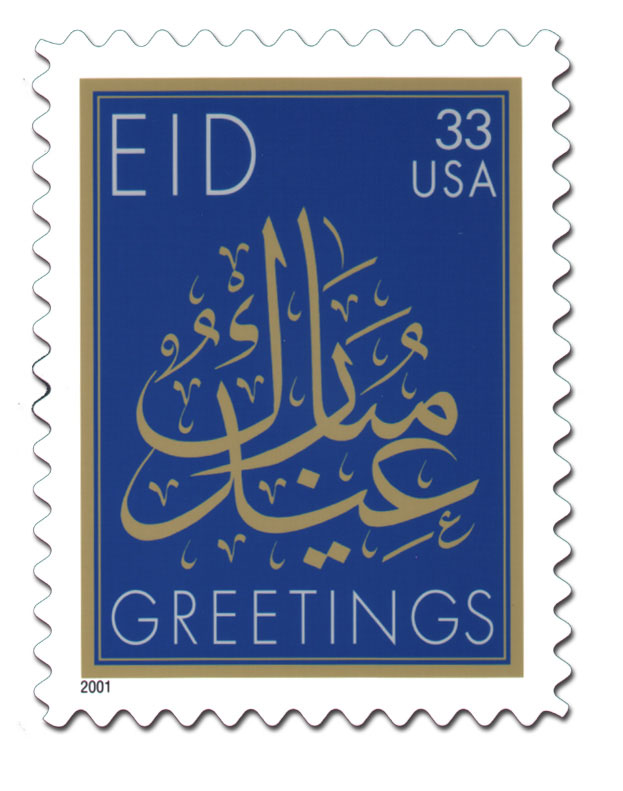
Now while tailoring stores to reach this consumer base is one important step for retailers, they should not forget that “the average Muslim consumer is much like the average American consumer, with wants and needs mainly dictated by their income, education, and type of family. Their socioeconomic status dictates their spending habits more than their religious affiliation.” (Y. Hafiz, 6/12/08) When speaking about Saatchi & Saatchi’s strategic ‘Lovemarks’ with Dilara Hafiz, co-author of The American-Muslim Teenager’s Handbook, she mused “…wow – it would be great if they saw a whole new field of Muslim consumers just eager to purchase products due to their amazing ads :) Seriously – there’s a lot of untapped buying potential amongst all these doctors & engineers.”
And as noted by Sara on her blog Muslim Canvas:
I guess the value I see in this marketing stuff is the effect it’ll have on the American psyche, rather than the Muslim psyche necessarily. An image of a hijabi mom spreading Jif peanut butter on her son’s sandwich, or of a long-bearded man answering the door on a Domino’s commercial, could go a long way for our ‘image’.
But this is not yet happening for several reasons. The first of which is that “part of the problem is that it is difficult for ad execs to create an advertising profile for Muslims as a whole, because [they] come from many diverse backgrounds and believe many different things.” (I. Hafiz, 6/12/08) Advertising is an industry that operates by committee – many rounds of approval and risk management – so there is an institutional aversion to engaging a seemingly complex demographic, one where there is the chance of ‘getting it wrong.’ (Robert, 9/7/08)
While Sara’s above point on Muslim Canvas is wholly correct, on the flipside there is the issue that “…portraying ‘Islam’ could fall into stereotypical depictions of women in headscarves and guys with long dishdashas and beards…in reality, any of the people in [any] commercial could be a Muslim, but unless they wear their faith in their clothing, it’s not something that will be obvious.”(Fakhraie, 6/12/08)

There is in fact a history of missteps by American businesses within the context of advertising and Islam – oddly enough none of them were borne out of an effort to reach the consumer demographic, but from using Islam as a backdrop or subtext for general market adverts. There is also an unspoken fear about engaging a supposedly ‘controversial’ consumer group – remember ˜terrorist/non-citizen”.
In a Spring 2008 campaign for Dunkin Donuts, spokeswoman Rachel Ray wore a scarf that looked like a keffiyeh. Conservative blogger and FOX analyst Michelle Malkin chided Ray for wearing a “jihadi chic” garment. In the ensuing media maelstrom Dunkin Donuts dropped the advert.
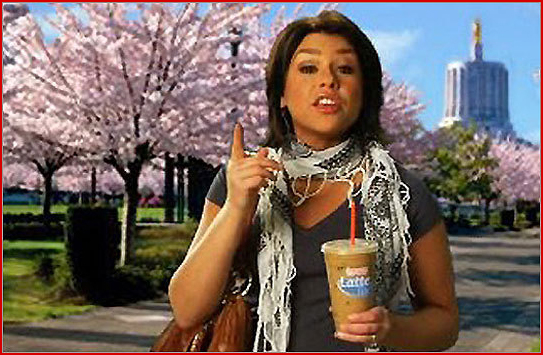
While I am certain that any brand considering this space will be aware of the inflammatory anti-Muslim backlash that foments in the blogosphere, I posit that this may be similar to the hurdles brands face when reaching out to gay and lesbian consumers. And as Saad Ahmad, the 20 year old author of the blog Chill Yo, Islam Yo, pointed out: “Seeing that we live in a capitalist society [including Islam] in advertising is really just an economic issue.” If there is money to be made, this may indeed happen. So soon come the adverts.
Cultural Citizenship: Film & TV
It is common knowledge in the US that the onscreen portrayals of Muslims/Middle Eastern/Arab/Desi is often not a positive experience. Chicago Tribune reporter Kiran Ansari notes that in the book Guilty: Hollywood’s Verdict on Arabs after 9/11
…author Jack Shaheen states that in the hundred new movies he reviewed about Arab characters in the post-9/11 period, 1 out of 4 are not even set in the Middle East, yet they have a dubious Arab character thrown in. And although I realize that no one should rely on Hollywood as a source of information, a misrepresentation of any issue or minority group can trickle down to become public perception.

While there may actually be an upswing in positive portrayals within small independent films, there is also the danger of falling into the same reductive typecasting that created the Hollywood stock character of the Magic Negro: African-American characters that exist because most Hollywood screenwriters don’t know much about black people…so instead of getting life histories or love interests, they get magical powers” that ultimately serve to benefit the white protagonists.
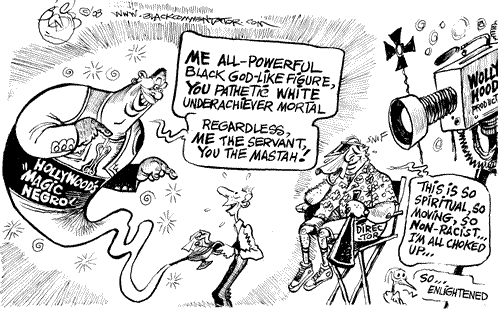
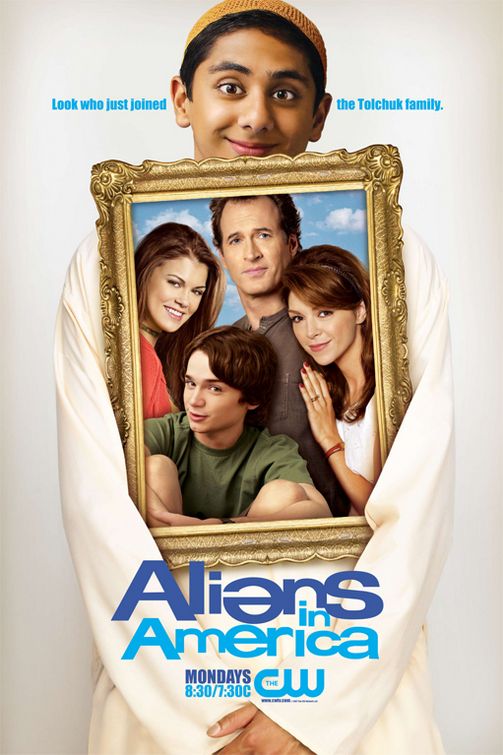
The 2007 CW series Aliens in America treads in this territory, in which the character Raja, a Pakistani-Muslim exchange student in Wisconsin, served as a vehicle for the other characters to become more enlightened about the world. As noted by the blog Ultrabrown in an extensive review of the show’s place within our national narrative, it “gives a middle-class Pakistani kid a kurta, a fakey accent and a higher Allah-per-sentence ratio than a Wahhabi cleric. So last night’s premiere was, of course, a big hit with the mainstream media.” The Magical Muslim is a “comical friendly ‘terrorist’ [who] can win the hearts of a white community and an American viewership.”
Again, keeping Volpp’s identity conflation in mind, I think a more exciting moment was the 2005 film Harold and Kumar go to White Castle. The brilliance of this film is that it is the first time a Hollywood feature portrayed an Indian-American and a Korean-American as ‘Red Blooded American Males’. Like millions of other American men in the 18-34 demographic, Harold & Kumar’s prime objective was a holy trinity of bong hits, bare breasts + burgers. Ever present were their races and cultures, but instead of being mined as tropes for pathos, the exotic, or education they were well employed as one of many narrative and comic elements.
Many people loved Harold and Kumar as the first bawdy blockbuster that spoke to their same-but-different status as hyphenated Americans. While the character Kumar, played by Kal Penn, is not tied to any religion, multiple times in the film White-Americans engage him as if he were a terrorist/ non-citizen/Muslim.

The film was popular enough at the box office to spawn the 2008 sequel Harold and Kumar Escape From Guantanamo Bay. And while it’s not very good film, cultural critic Oliver Wang points out that it’s actually “…an achievement of a kind too, proof that Asian Americans have made it far enough into the Hollywood machine that they can make perfectly mediocre mainstream fare as much as the next folks. Woo hoo, the promised land.” Boring as the rest of us, welcome to America.
What’s next? Hollywood studio 20th Century Fox has acquired the US rights to develop a version of the popular Canadian CBC TV show Little Mosque on the Prairie. Having a sitcom that is centered on an ethnic, religious, racial or social group is another American rite of passage. While many of these shows do fall into reductive stereotype, some become historic, like The Cosby Show, heralded throughout mass media for “it’s help in improving race relations by projecting universal values that both Whites and Blacks could identify with, using the tried and true format of the television sitcom.” (Feagin & Inniss 1995)

Will Little Mosque have such a profound effect? If nothing else, it will make waves as the first of it’s kind in the US, a space in which lines like: “It’s a perfect Muslim solution – nobody is happy” are not pernicious, but funny. The blog Muslimah Media Watch has done a brilliant job in parsing the first two seasons of the CBC show and reminds us that it “portrays a certain group of Muslims who follow Islam in a certain way. Although many Muslims may agree with most of the message, the message is still a conservative one.” Sobia from Muslimah Media Watch points out that even within this conservative rubric, we see “…husband and wife characters Yaser and Sarah…showing affection toward one another in public.” Amongst some this has raised the thread:
How dare she touch her husband’s ass in public? If Muslims are being depicted on television, they damn well better be behaving like ‘good’, ‘pure’, and ‘proper’ Muslims.
Sobia’s response is that this is:
A bit preachy if you ask me – and not to mention unrealistic! In my opinion, depicting Muslims engaging in lusty or affectionate behaviour…aides in the process of ‘normalizing’ us. After all, is this not how we behave? Do Muslim couples not show affection toward each other in public?…Or must we portray this facade of ‘virginal purity’ and display our modesty at all times?…Why must we shove morality, or at least one particular version of it, in everyone’s face.
What will be most interesting to see is how the mass media receives Little Mosque and reports on the subsequent public responses. Will there be product placement? In the Fall 2008 season of the CBC version, the massive Canadian insurance provider Cooperators is integrated into the narrative. Will the US version see Jiff or Dominoes in the kitchen? This could indeed help to achieve comedian Maz Jobrani’s hope that Americans begin to understand that Iranians bake cookies too – sans explosives.
It is indeed comedy that most often breaks down barriers between cultures, and at the vanguard of this is often standup comedy, which marks an “assimilat[ion] into the American way of self-lampooning or satirizing, which is part of the society.” Predating 20th Century Fox’s option on Little Mosque are two US comedy tours that have since made it onscreen – Axis of Evil and Allah Made Me Funny. As the producer of Axis said:
…this is the last stereotype to be broken down. In the same way you look back at Dick Gregory [black] or Latinos or gays, it’s very much a moment. There is always a moment in time when society was not ready to confront stereotypes. For people of Middle Eastern descent, [other] people aren’t quite ready to confront those stereotypes.

While both the film and tour of Allah Made Me Funny feature all Muslim comedians, only one of the four Axis of Evil comedians, Ahmed Ahmed, is a Muslim. Axis, which has played to wide audiences on Comedy Central, as has a special called The Watch List, engages the issue of conflation. In fact, comedian Dean Obeidallah, who is half Italian/half Palestinian, said in a PBS special that before 9/11, he “was just a white guy.” Since then, he has become more aware of and involved with his Arabic identity, first in response to how others defined it and then how he could “try to do something to define who we are, the right way…it’s up to us to go out there and do that.”
Mass media recognizing both the social and market value of this comic vein is invaluable, but Maz Jobrani reminds us that it is not about waiting for this to happen within mass media – it is about taking control as an individual author. When I interviewed him, Jobrani noted that:
People write to me and say “Hey Maz, why don’t you do this or talk about that?“ and my response is “No. Better yet – YOU can do this – with the tools of new media, I am not the only mouthpiece of Iranian comics – you too can make these jokes and get them out there to the masses” and this is a great thing.
Cultural Citizenship: New Media
Jobrani’s support of young comics to create and distribute their own content is symbolic of what I think is the most important act within the arena of ‘becoming’ American – authorship. Obedelliah chooses define himself in response to others foisting a (mis)identity upon him. Ali Ardekani created the YouTube world of Baba Ali. The American-Muslim Teenage Handbook was borne out of the Hafiz family’s realization that since “…there is no single head of Islam…why not define ourselves?”
This definition of self is inherently difficult within mass media, due to the ‘few senders and many receivers’ model. Minority groups often have but one or two examples of self that supposedly stand in for millions. Little Mosque will play that role soon within the American primetime TV space (likely a welcome replacement to the conflated villains within 24, Sleeper Cell, Traitor, etc.. ).
It is new media that offers the greatest opportunity for expression of self, as the space serves to “multiply rather than reduce the number and range of message producers and [is] far more interactive, not only in the minimal sense of an increased range of choice, than mass media.” Fatemeh Fakhraie, Editor-in-Chief of Muslimah Media Watch, which is both an analysis of mass media and an access point to all other Muslimah bloggers, started the blog “because I didn’t see any representation of Muslim women in either mainstream or feminist publications. We weren’t given a voice; we are only talked about.”
While we are looking at this identity construction within the space of Islam, over the last 10 years there have been many hyphenated Americans who, within the new media space, have been able to remix their identity within public space – and in turn secure for themselves a more powerful and complex voice within mass media. Three quick examples of note are:

Black Nerds
Over the last few years, we have seen a media rise in black skaters, black rockers, black videogamers and a successful new strain of hip-hop, all of which run counter to the standard mass media image of black man as athelete/rapper/criminal. Why? Director Raafi Rivero posits that perhaps:
The proliferation of media voices and sources enabled by the internet has allowed a more nuanced and less gangster voice of young black America to emerge, untempered by market concerns and sensationalism…that because of our more democratized communication tools we are beginning to see a more accurate depiction of black america. Mainly because, you know, that media is actually being created by, ahem, black people.
Gay/Lesbian
I recently interviewed a peer who had been struggling with his gay identity at the turn of the century – he knew that he was gay – but did not want to partake in the public ritual of attending gay bars/clubs. Nor did he want to ‘declare’ himself gay for fear that to do so was fraught with signifiers and would cause others (both hetero- and homo-) to reduce him to a stereotype. But via the internet he was able to find likeminded men, while their sexual inclinations were gay, they did not fit the mass media portrayal of homosexuality. By becoming empowered through this online space, he, and many of his friends decided to come out of the closet – a trend that we have seen as manifested in the ‘gay population explosion’ over the past 10 years. With an increased public presence, there is in turn a greater diversity of voices at the table.
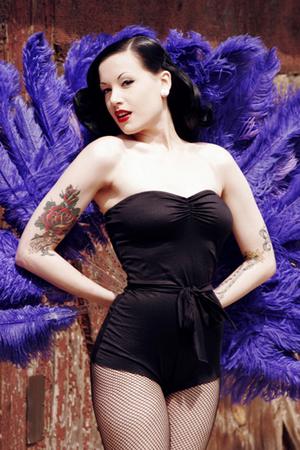
Sex Workers
The current trend of sexually forward and tart-tongued heroines in major films and TV shows (Washingtonienne, Juno, Secret Diary of a Call Girl) are all rooted in sex-worker literature – the majority of which began in the blogosphere. Also note the rise of Neo Burlesque and Suicide Girls. Via authoring and distributing their own stories, sex workers are now newly ‘revealed’ to be, of course, nuanced and complex human beings, or boring as the rest of us, not simply a ‘Hooker With a Heart of Gold’ or a ‘Dumb Tramp’.
Islam?
Where might new media take Islamic Identity in the US? Well even with the advent of comedy, sitcoms and Wal-Mart, Fatemeh of Muslimah Media Watch notes that:
Islam’s presence in [mass media] is increasingly religious, – things like beards, keffiyehs, terrorism, niqabs, and strict gender segregation and other “rules” are often what gets aired in the [mass media], and thus that’s what people think of when they hear Islam.
Offsetting this narrow scope, new media is the space within which one can tease out different aspects of his or her personality by being a creater/consumer or viewer/user. A young man can more easily be a Pious Muslim/Skater/Fan of Batman/Blogger all at once. Rather than waiting for mass-media to say OMG look at the soccerplaying hijabi, that teen, for whom this multiplicity is wholly normal, will be likely be online accessing those different parts of herself. And of course there is a robust Muslim blogosphere. What is so unique to online? It is
a sphere of creole discourse and creole journeys, an intermediate sphere between more private worlds and those of public rituals; it is part of a continuum between those along which social actors can move. Viewed statically, as languages, creoles appear mixed; but viewed dynamically, as speech communities, they look more like intermediate points on a continuum of activities and encounters that people enter and leave.(Anderson 2003)
It is the easiest space in which to be American, to be Muslim, to be both and beyond.
It is indeed these young folks who likely be at the vanguard of the morphing Islamic identity within America. While the runway chic of Balenciaga, Raf Simons and TSE have been mining the visual language of hijabs and keffiyehs far more important is the young design collective MSLM that remixes Islam with hip-hop style in Rotterdam. Fashion blogs like Hijab Style and We Love Hijab. The US teen magazine Muslim Girl, small-press hipster t-shirts that celebrate Ramadan and Hijabman’s tweaking of an old Irish saying. This content is disseminated, consumed and remixed by others online and authored by/for young Muslims.
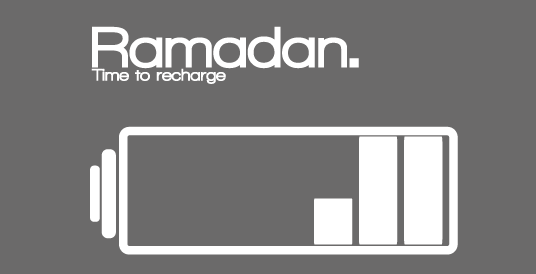

Online we see the comic strip Ninjabi, authored by a young woman in New Jersey, what she sees as “something for the new generation of muslim girls to look up to – a character cross between then popular powerpuff girls, and a somewhat devout muslim who cares for human rights, taking a hidden ninja lifestyle to help others.” And then a girl in Texas started another comic of the same name. Might there soon there be a third?
As media scholar Faris Yakob points out in his thesis I Believe The Children Are Our Future “If we look to those under 25, we see not incremental but qualitative shifts in behaviour. The generation gap has never been wider, because kids can control their own experiences of ideas in a way the generations that grew up before never could.” It is these digital natives who truly understand duality. They are the first generation who can bifurcate themselves, not with the negative connotations usually ascribed to such cleavage, but in a way that actually makes them more holistic.
They can likely slide between the terrorist/non-citizen label, and be both American and Muslim -not ‘become’ American as mass-media may be waiting to see, or confer – but be – as they already are. It is this new media space that will likely feed ‘new’ identity politics to advertising, film and mass media. It is this authorship that hopefully will diversely define the forthcoming Muslim Consumer space within America.
